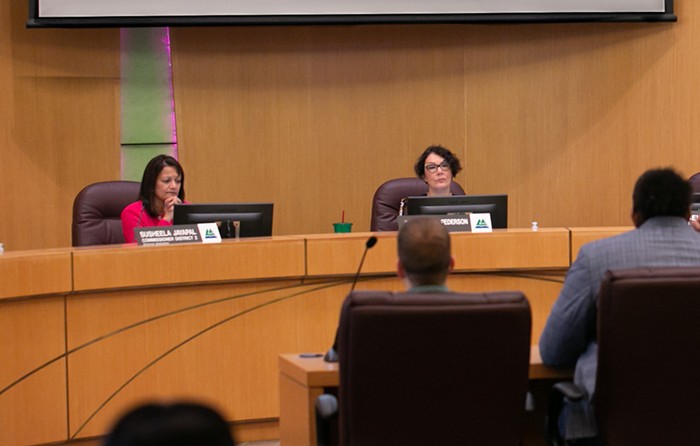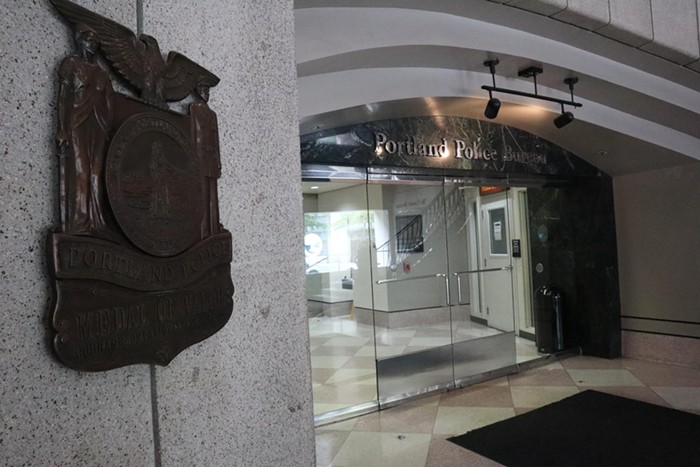
Even that short promise took more leverage than state environmental regulators could bring to bear. The Mercury has learned that the state Department of Environmental Quality has handed at least part of its oversight of air toxics to the state Department of Justice. Paul Garrahan, a staff attorney in charge of the natural resources section, elicited Bullseye's commitment to ditch all forms of chromium with a call Monday. The company formerly had only agreed to stop putting one type of the heavy metal into its furnaces.
The focus on chromium is new. In the midst of ongoing concerns about levels of cadmium and arsenic far exceeding state safe-air goals found last October, it was members of the community who directed DEQ to first consider chromium levels as well, DEQ Northwest Region Administrator Nina DeConcini revealed at a press conference on Friday.
At that press conference, DeConcini expressed uncertainty about DEQ's legal authority regarding the two glass factories that have raised such concern: Bullseye and Uroboros Glass in North Portland. Asked to cite the basis of that authority, she couldn’t. DeConcini said she would have to consult with outside counsel at the DOJ, Mr. Garrahan.
"As DOJ attorneys are DEQ's legal counsel, they are involved in providing legal advice to us to inform our decisions. They also represent us in legal matters, especially when other parties involved are represented by legal counsel," DeConcini said in an emailed statement.
As far as poison escaping Bullseye's flue, the company's assurances last week that it was suspending the use of toxic chromium VI were cold comfort. In announcing that move, the DEQ neglected to mention that, under the high-temperature conditions of a glass furnace, chromium compounds can change. The relatively benign trivalent chromium (chromium III) that Bullseye, until yesterday, said it would still use, could morph into the truly toxic version, chromium VI.
Perhaps realizing that, DOJ's Garrahan got the company to agree to punt all chromium for at least a week. It remains to be seen how long that will last.
The problem for Bullseye's neighbors was explained by Andrea Goforth, associate professor of chemistry at Portland State University. Various forms of chromium subjected to a glass furnace's 2400-degree Fahrenheit heat can oxidize and lose electrons. Some of that will escape up Bullseye's flue as vapor. Once outside, this “electron-hungry” form of chromium (as Goforth put it) might be inhaled by someone within range of Bullseye's fugitive emissions.
Chromium VI is dangerous because it in effect steals electrons from the biological agent—such as lung tissue—that it encounters. The human body tries to compensate for the missing electrons as best it can, often in botched, anomalous fashion. Bad outcomes—such as altered cell reproduction, damaged genetic material, or cancer—might result, said Goforth.
Ironically, Bullseye's introduction of liquid oxygen as a fuel for its furnaces back in 2005 only adds to the problem, since, said Goforth, it “encourages the stripping of electrons” thus yielding more chromium VI. The increased oxygen in the fuel also increases the oxidation of other metals, she added.
Daniel Forbes is the author of Derail this Train Wreck. He lives in Portland, and can be reached at ddanforbes@aol.com.
MORE COVERAGE:
State Finds Alarmingly High Arsenic, Cadmium Levels Near Two SE Portland Schools
Bullseye Glass Has Suspended Use of Arsenic and Cadmium Because of Air Quality Concerns
Portland Public Schools Is Ordering Air Tests Because of Arsenic, Cadmium Concerns: "We Need A Public Meeting"
Soil Near Bullseye Glass Contains Arsenic and Cadmium—And Other Things Officials Told Parents Thursday
Essential Pollution Controls Lacking at Two Glass Plants Blamed For Cadmium Emissions


















